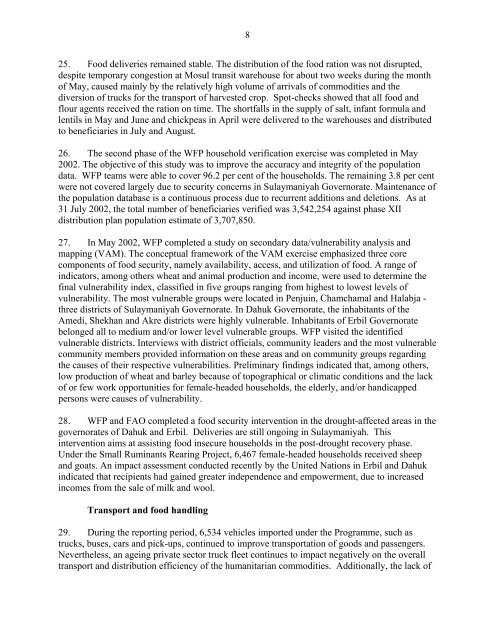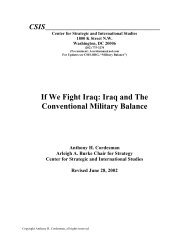I. Introduction II. Revenue generation
I. Introduction II. Revenue generation
I. Introduction II. Revenue generation
You also want an ePaper? Increase the reach of your titles
YUMPU automatically turns print PDFs into web optimized ePapers that Google loves.
825. Food deliveries remained stable. The distribution of the food ration was not disrupted,despite temporary congestion at Mosul transit warehouse for about two weeks during the monthof May, caused mainly by the relatively high volume of arrivals of commodities and thediversion of trucks for the transport of harvested crop. Spot-checks showed that all food andflour agents received the ration on time. The shortfalls in the supply of salt, infant formula andlentils in May and June and chickpeas in April were delivered to the warehouses and distributedto beneficiaries in July and August.26. The second phase of the WFP household verification exercise was completed in May2002. The objective of this study was to improve the accuracy and integrity of the populationdata. WFP teams were able to cover 96.2 per cent of the households. The remaining 3.8 per centwere not covered largely due to security concerns in Sulaymaniyah Governorate. Maintenance ofthe population database is a continuous process due to recurrent additions and deletions. As at31 July 2002, the total number of beneficiaries verified was 3,542,254 against phase X<strong>II</strong>distribution plan population estimate of 3,707,850.27. In May 2002, WFP completed a study on secondary data/vulnerability analysis andmapping (VAM). The conceptual framework of the VAM exercise emphasized three corecomponents of food security, namely availability, access, and utilization of food. A range ofindicators, among others wheat and animal production and income, were used to determine thefinal vulnerability index, classified in five groups ranging from highest to lowest levels ofvulnerability. The most vulnerable groups were located in Penjuin, Chamchamal and Halabja -three districts of Sulaymaniyah Governorate. In Dahuk Governorate, the inhabitants of theAmedi, Shekhan and Akre districts were highly vulnerable. Inhabitants of Erbil Governoratebelonged all to medium and/or lower level vulnerable groups. WFP visited the identifiedvulnerable districts. Interviews with district officials, community leaders and the most vulnerablecommunity members provided information on these areas and on community groups regardingthe causes of their respective vulnerabilities. Preliminary findings indicated that, among others,low production of wheat and barley because of topographical or climatic conditions and the lackof or few work opportunities for female-headed households, the elderly, and/or handicappedpersons were causes of vulnerability.28. WFP and FAO completed a food security intervention in the drought-affected areas in thegovernorates of Dahuk and Erbil. Deliveries are still ongoing in Sulaymaniyah. Thisintervention aims at assisting food insecure households in the post-drought recovery phase.Under the Small Ruminants Rearing Project, 6,467 female-headed households received sheepand goats. An impact assessment conducted recently by the United Nations in Erbil and Dahukindicated that recipients had gained greater independence and empowerment, due to increasedincomes from the sale of milk and wool.Transport and food handling29. During the reporting period, 6,534 vehicles imported under the Programme, such astrucks, buses, cars and pick-ups, continued to improve transportation of goods and passengers.Nevertheless, an ageing private sector truck fleet continues to impact negatively on the overalltransport and distribution efficiency of the humanitarian commodities. Additionally, the lack of
















